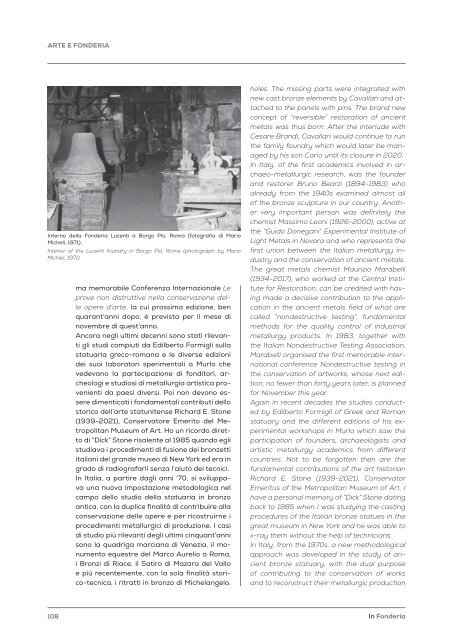In Fonderia 3 2023
Terzo numero del 2023 di In Fonderia
Terzo numero del 2023 di In Fonderia
You also want an ePaper? Increase the reach of your titles
YUMPU automatically turns print PDFs into web optimized ePapers that Google loves.
ARTE E FONDERIA<br />
<strong>In</strong>terno della <strong>Fonderia</strong> Lucenti a Borgo Pio, Roma (fotografia di Mario<br />
Micheli, 1971).<br />
<strong>In</strong>terior of the Lucenti foundry in Borgo Pio, Rome (photograph by Mario<br />
Micheli, 1971).<br />
ma memorabile Conferenza <strong>In</strong>ternazionale Le<br />
prove non distruttive nella conservazione delle<br />
opere d’arte, la cui prossima edizione, ben<br />
quarant’anni dopo, è prevista per il mese di<br />
novembre di quest’anno.<br />
Ancora negli ultimi decenni sono stati rilevanti<br />
gli studi compiuti da Edilberto Formigli sulla<br />
statuaria greco-romana e le diverse edizioni<br />
dei suoi laboratori sperimentali a Murlo che<br />
vedevano la partecipazione di fonditori, archeologi<br />
e studiosi di metallurgia artistica provenienti<br />
da paesi diversi. Poi non devono essere<br />
dimenticati i fondamentali contributi dello<br />
storico dell’arte statunitense Richard E. Stone<br />
(1939-2021), Conservatore Emerito del Metropolitan<br />
Museum of Art. Ho un ricordo diretto<br />
di “Dick” Stone risalente al 1985 quando egli<br />
studiava i procedimenti di fusione dei bronzetti<br />
italiani del grande museo di New York ed era in<br />
grado di radiografarli senza l’aiuto dei tecnici.<br />
<strong>In</strong> Italia, a partire dagli anni ’70, si sviluppava<br />
una nuova impostazione metodologica nel<br />
campo dello studio della statuaria in bronzo<br />
antica, con la duplice finalità di contribuire alla<br />
conservazione delle opere e per ricostruirne i<br />
procedimenti metallurgici di produzione. I casi<br />
di studio più rilevanti degli ultimi cinquant’anni<br />
sono la quadriga marciana di Venezia, il monumento<br />
equestre del Marco Aurelio a Roma,<br />
i Bronzi di Riace, il Satiro di Mazara del Vallo<br />
e più recentemente, con la sola finalità storico-tecnica,<br />
i ritratti in bronzo di Michelangelo,<br />
holes. The missing parts were integrated with<br />
new cast bronze elements by Cavallari and attached<br />
to the panels with pins. The brand new<br />
concept of “reversible” restoration of ancient<br />
metals was thus born. After the interlude with<br />
Cesare Brandi, Cavallari would continue to run<br />
the family foundry which would later be managed<br />
by his son Carlo until its closure in 2020.<br />
<strong>In</strong> Italy, of the first academics involved in archaeo-metallurgic<br />
research, was the founder<br />
and restorer Bruno Bearzi (1894-1983) who<br />
already from the 1940s examined almost all<br />
of the bronze sculpture in our country. Another<br />
very important person was definitely the<br />
chemist Massimo Leoni (1926-2000), active at<br />
the “Guido Donegani” Experimental <strong>In</strong>stitute of<br />
Light Metals in Novara and who represents the<br />
first union between the Italian metallurgy industry<br />
and the conservation of ancient metals.<br />
The great metals chemist Maurizio Marabelli<br />
(1934-2017), who worked at the Central <strong>In</strong>stitute<br />
for Restoration, can be credited with having<br />
made a decisive contribution to the application<br />
in the ancient metals field of what are<br />
called “nondestructive testing”, fundamental<br />
methods for the quality control of industrial<br />
metallurgy products. <strong>In</strong> 1983, together with<br />
the Italian Nondestructive Testing Association,<br />
Marabelli organised the first memorable international<br />
conference Nondestructive testing in<br />
the conservation of artworks, whose next edition,<br />
no fewer than forty years later, is planned<br />
for November this year.<br />
Again in recent decades the studies conducted<br />
by Edilberto Formigli of Greek and Roman<br />
statuary and the different editions of his experimental<br />
workshops in Murlo which saw the<br />
participation of founders, archaeologists and<br />
artistic metallurgy academics from different<br />
countries. Not to be forgotten then are the<br />
fundamental contributions of the art historian<br />
Richard E. Stone (1939-2021), Conservator<br />
Emeritus of the Metropolitan Museum of Art. I<br />
have a personal memory of “Dick” Stone dating<br />
back to 1985 when I was studying the casting<br />
procedures of the Italian bronze statues in the<br />
great museum in New York and he was able to<br />
x-ray them without the help of technicians.<br />
<strong>In</strong> Italy, from the 1970s, a new methodological<br />
approach was developed in the study of ancient<br />
bronze statuary, with the dual purpose<br />
of contributing to the conservation of works<br />
and to reconstruct their metallurgic production<br />
108 <strong>In</strong> <strong>Fonderia</strong>














